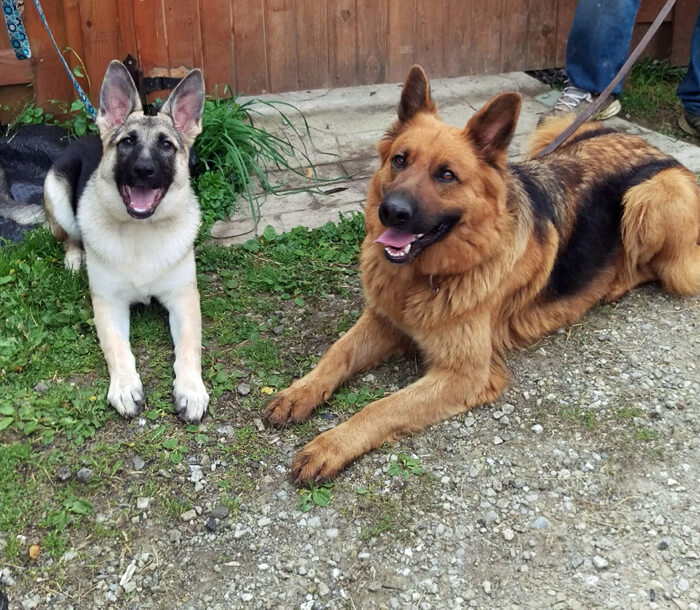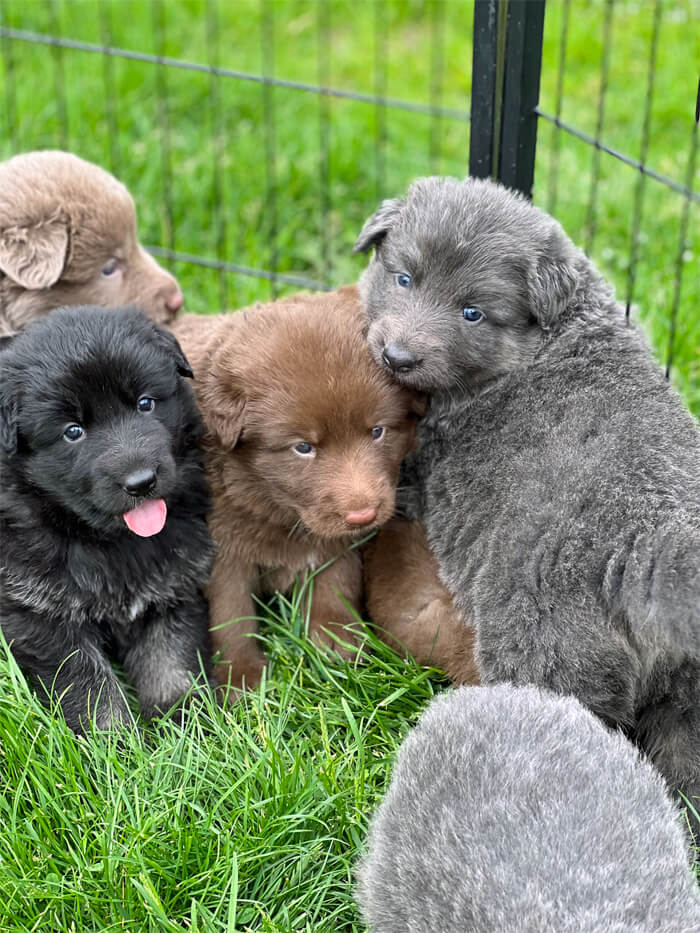- 740-213-3992
- 40921 Kindall Rd, Woodsfield, OH 43793

German Shepherds are a popular and versatile breed, known for their intelligence, loyalty, and impressive work ethic. However, within the German Shepherd community there are distinct lines of breeding that result in different characteristics and physical traits. This page aims to explore the differences between these lines and the traits that make each of them unique.
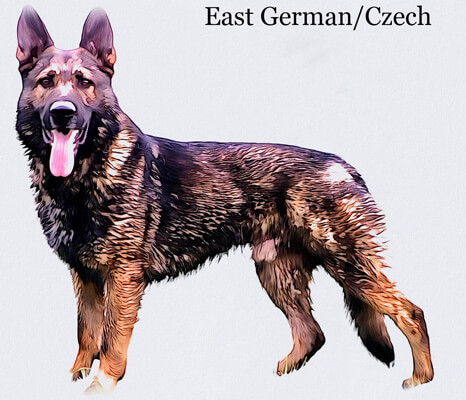
The East German dog was a GSD bred specifically to work. Very high drive, heavier boned and shorter in stature with a straight backed appearance, this dog MUST have a job. Colors are typically sable, solid black and black and tan. They are the dog of choice for most police forces given their intense nature, and smaller stature makes them perfect for apprehending criminals and doing the difficult and exhausting tracking and scent work required.
They thrive on activity.
Their high prey drive and activity level make this a dog best suited to a very experienced handler or someone who has the time and resources to channel the boundless energy into productive activities. In the wrong hands this dog can be a very destructive and even dangerous canine. We do not breed for this level of drive, but we appreciate the strong working ethic and health of these bloodlines.
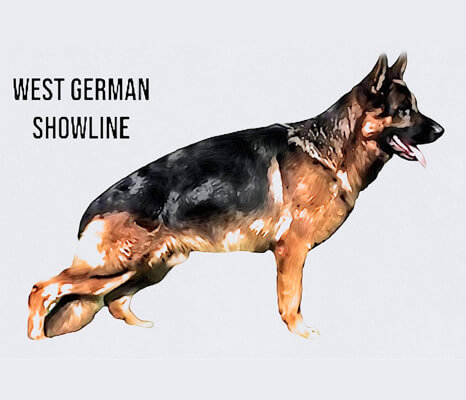
The West German dogs can be divided into two categories- Show lines and working lines. In the show lines, emphasis was for a dog that was taller, leaner, with a roached backed appearance. Black and tan and black and red plush coats were the desired type. Although they still have a great deal of drive they are not as driven as the working lines.
In the West German working lines, the dog was expected to maintain a high level of drive and ability similar to what was seen in the East German and Czech DDR lines.
These dogs are typically black and red, black and tan, and can be solid black and sable.
We appreciate the beauty and drive of these lines and have numerous lines with West German dogs in their pedigree. Unfortunately due to the very strict breeding criteria (coat and color) many of the lines in Germany/Europe have become unstable due to the limited gene pool available and the detrimental results of inbreeding. Elbow/hip dysplasia and reproductive disorders are becoming far too common. We have had a number of disappointments with West German dogs not passing critical health tests for breeding. Moving forward, We will continue to cautiously include great dogs with West German pedigrees in our breeding program and are currently working with several reputable breeders in Europe.
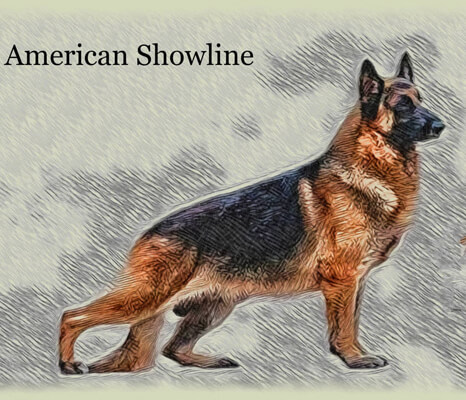
Throughout the centuries the American show lines have been bred for one main purpose, and that is to look beautiful.
Most of these dogs have a heavily angulated rear, sloped back, and their gait is highly exaggerated.
Although they may look stunning trotting around the ring at a dog show, we do not approve of the extreme angulation/conformation promoted in these lines. Instead we prefer A moderate angulation which promotes a more natural body movement and healthy hip/joint structure. We appreciate the beauty of these lines but do not breed for the American Show line body style. Recently there has been a movement to correct these extremes in angles, however, the breeders who created and the judges who championed these dogs perpetuated this body style over a period of many years and so it will take some time to correct.
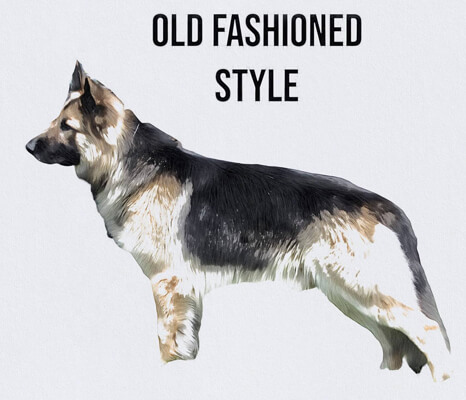
The Old fashioned, or farm style GSD was a movement created by breeders in the U.S. who desired a large calmer Shepherd suitable for living on the farms and in the homes of families. This style of Shepherd is also produced by many breeders in the UK . The Old fashioned style of GSD is often larger than the standard, has a straight back, calm enough to be with other pets and livestock without undue excitement, and gentle enough to be a great home and family companion. Colors can range from traditional black/tans, black/reds to solid blacks, solid whites, sables, and the more exotic blues, fawns and livers. We love the size, colors and versatility of these lines. They make excellent family pets and are a good choice for a first time shepherd owner.
The German Shepherd should have a thick double coat. The double coat is important in a working dog to ensure protection from the elements. The outer coat may be short, plush, or long. A short or tight coat is very short, laying close to the body. A plush coat is the desired coat type for conformation events, being fuller and thicker than a short coat. The long coat is much fuller than a plush, and is characterized by long tufts of fur around the dog’s ears, “trousers” on the hind legs, a very full tail, and longer hair over the entire body. The long coat is not allowed in AKC conformation events, but recently has started being permissible in Germany after decades of this coat style being disallowed. It is thought the long coats are important to help maintain the proper coat texture and fullness in the GSD breed.
Whatever your preference, all of these coat types must have present the soft downy undercoat, characteristic of a true double coated breed. Dogs without this undercoat have a serious breed fault and should not be used in breeding programs.
Pictured is Ruger, long coat( in front), Bo, Plush coat, and Nahla a short (tight) coat.
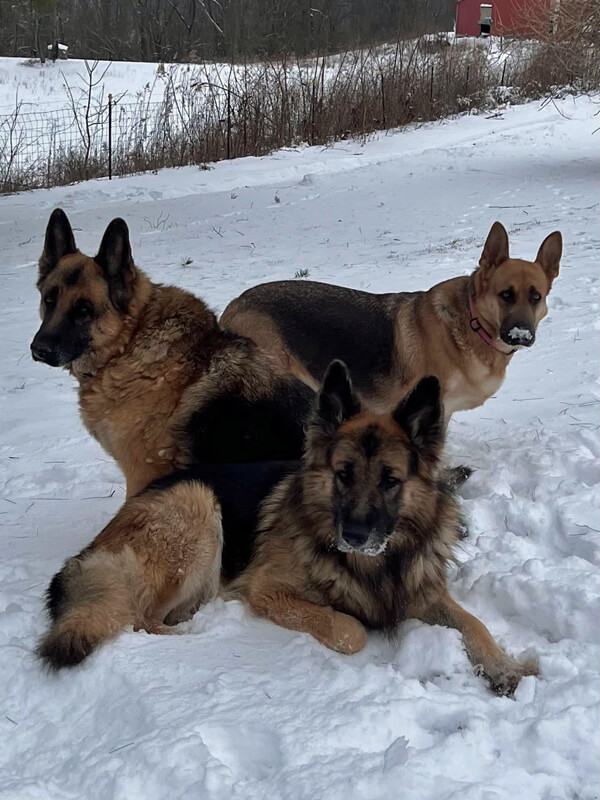
The GSD can exhibit several coat patterns which include saddle, bi-color, solid, and sable.
The saddle pattern is the most widely recognized and dominant color pattern. Here the dog has a darker saddle over the back, and usually black markings on the legs and tail.
The Bi-color has the darker color, all over the body so it appears almost completely black except for lighter color under the tail, on the toes, and facial markings.
The sable pattern is a type of pattern with darker and lighter hairs mixing to create a distinct wolf-like color all over the body.
The GSD can also be solid color, most commonly solid white or solid black.
White markings– It is common for the GSD to exhibit some white markings on the body, on the chest and toes usually, but never on the back or sides.
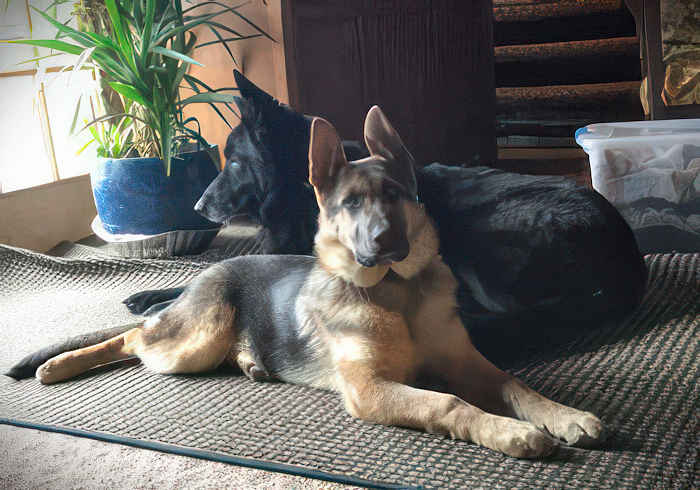
The German Shepherd can surprisingly come in many different colors other than the classic Black/Tan most people are familiar with.
Black/Tan is the most common seen color in the GSD and the body is a shade of tan or light brown and the saddle or cape is black.
Black/Red– same as the black/tan but the tan is reddish or rust hued and darker.
Solid black-The Solid black color is caused by a recessive gene that must be inherited from both parents. More rarely, some shepherds have a dominant variant of this gene and the dominate black dog can produce solid color pups with any other coat pattern of dog.
Solid White- The white is actually not a color in the German Shepherd but a Masking gene.Two copies of this gene must be inherited in order for a GSD to be born white. The genetic color of the dog can be anything and thus a solid white GSD can produce puppies that are colored.
Note: the White Swiss or Berger Blanc Swiss dog is a solid white long coat developed in Switzerland and descended from purebred white German Shepherd dogs. White Swiss dogs are often registered as German Shepherd dogs here in the USA and are genetically a sub type of German Shepherd.
Sable– the dog can be a gray sable, red sable, tan sable, or black sable depending on the degree.
The exotic colors are further explained below:
